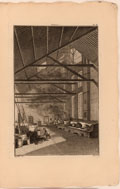SUGAR AND THE SPECTER OF CANNIBALISM Cannibalism was long associated with the indigenous peoples of the Americas and Sub-Saharan Africa. It acquired new meaning when abolitionists used it to dramatize the suffering and death of slaves who produced sugar for European consumption. Abolitionists turned the tables on Europeans by accusing them of being cannibals when they ate sugar tainted with the flesh and blood of slaves. White abolitionists and black abolitionist Olaudah Equiano also famously wrote that Africans believed white people were cannibals. Europeans were rarely pictured as cannibals—this was a literary trope. The pro-slavery caricature by Gillray shown here is a sensationalized exception. |
||
Blood, Sweat and Tears This frontispiece for an anti-slavery tract, likely written by a European posing as a slave ("Le More-Lack"), emphases the blood, sweat, and tears expended by a slave in producing the sweetened beverages on the table in this West Indian scene. While the image shows a white man beating a hungry slave, the even more horrible specter of white cannibalism is raised only in the inscription ("Those who drink my blood, my sweat and my tears … refuse me a piece of bread and beat me"). |
||
William Fox, An Address to the people of Great Britain on the propriety of abstaining from West Indian sugar and rum. [London], 1791.
|
||
Caricaturing Atrocity on a Sugar Plantation This pro-slavery print is a satiric effort to discredit testimony given before the British Parliament during debates on ending the slave trade. The testimony claimed that a white slave driver had thrown a slave into a vat of boiling sugar as punishment. Caricature depends on exaggeration, and here Gillray maximizes the horror in order to show how supposedly absurd abolitionist testimonies of such atrocities were. |
||
Cannibal Hell In a hellscape compressed into the foreground, these Brazilian natives represent the height of exotic barbarism; wearing elaborate headdresses, they cook a human in a pot. Animal parts and a human leg hang overhead. This grisly collection of parts eerily resonates with the one on the wall in Gillray’s Barbarities, published a century later. While the British caricature is deeply satiric, this Dutch print indulges in a bit of wit by way of contrast: the cannibals’ cooking pot echoes the round bath containing indigenous Virginians in the Arcadian background. |
||
Elegant Cannibals Tupinamba (from Brazil) prepare a human victim for boiling in this engraving that illustrates a republication of an early account (1557) by Hans Staden of cannibalism in the New World. Unlike Gillray's monstrous slave driver, the cannibals in this early eighteenth-century engraving are represented as idealized nudes. The standing female in the center manages a graceful pose as she raises the victim's severed arm. Horror and aesthetic pleasure are both on offer here. |
||
Blood in the Refinery |
||
Blood, Refinement, and Pollution |
||
Exhibition may be seen in Reading Room from SEPTEMBER 2013 through december 2013. K. Dian Kriz (Professor Emerita of History of Art and Architecture, Brown University), guest curator, with assistance from Susan Danforth (Curator of Maps and Prints); Elena Daniele (JCB Stuart Fellow 2012-13), curatorial assistant. |


Images: "The Buildings of Maran Estate in the Island of Grenada. The Property of Thomas Duncan Esqr. Novr. 1822."






